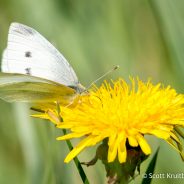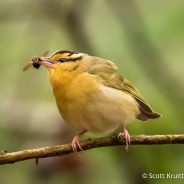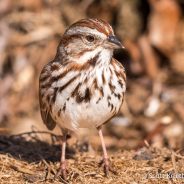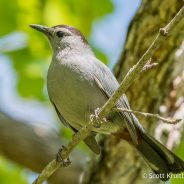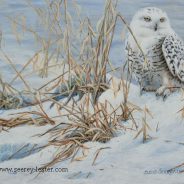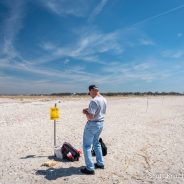I love this time of year. After the exuberance of summer and the vibrant colors of fall, I’m thankful for the days growing shorter. The nights longer. Temperatures falling. Silhouettes of bare branches against a leaden sky promising snow. All of nature winding down. Encouraging quiet. Reflection. Introspection. [more]
Barred Owl (Strix varia)
This Barred Owl (Strix varia) saw me long before I saw it, monitoring my movements from afar while perched in this tree on a cloudy May morning. Those enormous dark eyes tracked me in a relaxed fashion as I was still rather far away when I noticed it. I had been watching several warblers and a Blue-gray Gnatcatcher before my eyes stumbled on this slightly larger species. Barred Owls are, of course, usually snoozing during the day, but not always – and the spring season is when I have seen them the most active diurnally. This bird did...
read moreCabbage White
The Cabbage White (Pieris rapae) is a non-native “pest” butterfly species, and here you can see it is feeding on a Dandelion (Taraxacum officinale), a non-native weed…but you know what, the ship has sailed on trying to solve that problem. I realize that is easy for me to say because I am not employed in agriculture. However, we are not going to wake up tomorrow and eliminate these species from North America. Even if we were to try it would be terribly harmful, and in the case of the dandelion we would be pumping even more...
read moreWorm-eating Warbler (Helmitheros vermivorum)
I was thrilled to find and then get great views of this Worm-eating Warbler (Helmitheros vermivorum) singing and feeding earlier today. I first heard its insect-like trill of a song from along a steep, rocky slope in the forest featuring a lot of vegetation in the understory – precisely what they want for the breeding season. We in the Northeast are at the northern edge of their range, and finding the uncommon birds can be difficult. Worm-eating Warbler populations are said to be stable, but they certainly do decline and increase in...
read moreIntern Night Tonight – May 4, 2016
Please join us at RTPI on Wednesday May 4 from 6-7pm for a night of fun and learning as we enjoy presentations from two of RTPI’s fantastic interns. Alex Shipherd and Bryce Alexander, both Jamestown Community College students, have spent much of the spring semester assisting in winter raptor and hemlock woolly adelgid studies, respectively. Throughout the winter field season, Alex monitored known locations of roosting Northern Harriers and Short-eared owls within Chautauqua and Cattaraugus Counties while using GIS to find other probable...
read moreSong Sparrow
What is one thing nearly all of the sparrows have in common? Those special earth tones, with varying shades of brown making up a lot of their appearance because they are ground-based birds. This Song Sparrow was showing that off with its camouflage working wonderfully and apparently letting it feel comfortable enough to let me shoot these close-up photos. They really are brilliant little birds, and I mean that for all the many subspecies of Song Sparrow in the world. One wonders how many of these would or will evolve to completely different...
read moreRusty Blackbird Blitz 2016 Update
Thank you to everyone who has submitted Rusty Blackbird sightings to eBird this spring! Although today marks the close of the target Blitz dates in Connecticut, the Blitz isn’t over! In 2015, Rusty migration was later than usual through many states, and birders were reporting Rusty Blackbirds in some southern states in early April, and in northern states through early May. Even outside of our official Blitz window for Connecticut, we still need all of your Rusty Blackbird observations to help understand Rusty Blackbird migratory timing and...
read moreGray Catbird
This was – finally! – my first of year Gray Catbird last week, and it took a lot of work to even get these photos of this shy bird. While Gray Catbirds are often a bit secretive, less so than their relative the Brown Thrasher, I can usually get them to pop up for a moment or chat with me more than this bird wanted to. I really had to lighten these photos of it in the shadows. It did not mind going right over my head, peering down at me while giving that cautious eye. However, many more of the species will be pouring through the...
read moreKeeping the World Wild
Keeping the World Wild The Art of John and Suzie Seerey-Lester June 17 – August 28, 2016 RTPI is very pleased to announce a new exhibition featuring original works by John and Suzie Seerey-Lester this summer! “Keeping the World Wild” will give visitors a glimpse into the inspiring work of this incredible artist duo. With work hanging at the White House and in permanent, private and Museum collections throughout the world, John Seerey-Lester has become one of the most renowned of today’s wildlife and historic artists. He moved to America over...
read moreFencing & Signage Operations Complete
Last week we finished string fencing and signage operations for the Audubon Alliance for Coastal Waterbirds on our Connecticut beaches. We had a tremendous volunteer turnout at some of the most difficult and critical sites including Sandy/Morse Points in West Haven, Bluff Point State Park in Groton, and Long Beach in Stratford. It was a gorgeous April day for this work at Long Beach, and most of it was completed in only a few hours thanks to the terrific help. This work was completed just in time as we now have the first Piping Plover and...
read moreBrown Thrasher
The Brown Thrasher (Toxostoma rufum) was another photographic target of mine this spring. I typically do get to enjoy the species a bit each April and May, but they are difficult subjects to shoot. Part of the problem is that they have dramatically dropped in abundance since Roger Tory Peterson’s time which makes me appreciate moments like these all the more. For a species that was a tolerably common breeding bird for many people, including Roger’s homes in New York and Connecticut, is now often a ghost in both behavior and population....
read more




